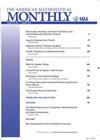Six Houses and Three Utilities on A Coffee Mug
IF 0.4
4区 数学
Q4 MATHEMATICS
引用次数: 0
Abstract
In a recent Monthly article [1], Hammack and Kainen displayed drawings of the complete bipartite graphs K3,3 and K4,4 on the torus without crossed edges. Notice that if K3,n can be so drawn on the torus, then by the Euler characteristic, 0 = V − E + F = (3 + n) − 3n + F . Each face has at least four edges, and each edge is shared by two faces, so F ≤ E/2 = 3n/2. Therefore, 0 ≤ 3 − 2n + 3n/2, so n ≤ 6. It is known that this necessary condition is also sufficient [1]. The graph K3,3 has been posed as a classical puzzle about connecting three houses with three utilities without crossing utility lines. This is impossible on the sphere (or plane) but possible on a torus, or equivalently, on a coffee mug. In fact, such a puzzle on a coffee mug has been popularized by an entertaining star-studded video [2]. Therefore, it would make a more challenging puzzle to put on a coffee mug six houses a, b, c, d, e, and f , and three utilities u, v, and w! Two solutions are shown below, by gluing the opposite sides of the square or hexagon to make a torus. In the less familiar hexagonal identification [3, pp. 4–5], we glue the top and bottom sides first to get a cylinder, then we glue the two end-circles of the cylinder with a 180◦ twist to obtain a torus.六栋房子和三个公用设施在一个咖啡杯上
在最近的一篇月刊文章[1]中,Hammack和Kainen展示了环面上没有交叉边的完全二部图k3,3和k4,4的图。注意,如果K3,n可以这样画在环面上,那么根据欧拉特性,0 = V - E + F = (3 + n) - 3n + F。每个面至少有四条边,每条边由两个面共享,故F≤E/2 = 3n/2。因此,0≤3−2n + 3n/2,则n≤6。已知这个必要条件也是充分条件。图k3,3是一个经典的谜题,关于连接三个房子和三个公用设施,而不跨越公用线路。这在球体(或平面)上是不可能的,但在环面或咖啡杯上是可能的。事实上,这样一个咖啡杯上的谜题已经被一个明星云集的娱乐视频所普及。因此,在一个咖啡杯上放六个房子a、b、c、d、e和f,以及三个公用事业单位u、v和w,这将是一个更具挑战性的谜题!下面展示了两种解决方案,将正方形或六边形的相对边粘合成一个环面。在不太熟悉的六角形识别中[3,第4-5页],我们先粘合顶部和底部得到一个圆柱体,然后我们粘合圆柱体的两个端圆180度扭转得到一个环面。
本文章由计算机程序翻译,如有差异,请以英文原文为准。
求助全文
约1分钟内获得全文
求助全文
来源期刊

American Mathematical Monthly
Mathematics-General Mathematics
CiteScore
0.80
自引率
20.00%
发文量
127
审稿时长
6-12 weeks
期刊介绍:
The Monthly''s readers expect a high standard of exposition; they look for articles that inform, stimulate, challenge, enlighten, and even entertain. Monthly articles are meant to be read, enjoyed, and discussed, rather than just archived. Articles may be expositions of old or new results, historical or biographical essays, speculations or definitive treatments, broad developments, or explorations of a single application. Novelty and generality are far less important than clarity of exposition and broad appeal. Appropriate figures, diagrams, and photographs are encouraged.
Notes are short, sharply focused, and possibly informal. They are often gems that provide a new proof of an old theorem, a novel presentation of a familiar theme, or a lively discussion of a single issue.
Abstracts for articles or notes should entice the prospective reader into exploring the subject of the paper and should make it clear to the reader why this paper is interesting and important. The abstract should highlight the concepts of the paper rather than summarize the mechanics. The abstract is the first impression of the paper, not a technical summary of the paper. Excessive use of notation is discouraged as it can limit the interest of the broad readership of the MAA, and can limit search-ability of the article.
 求助内容:
求助内容: 应助结果提醒方式:
应助结果提醒方式:


